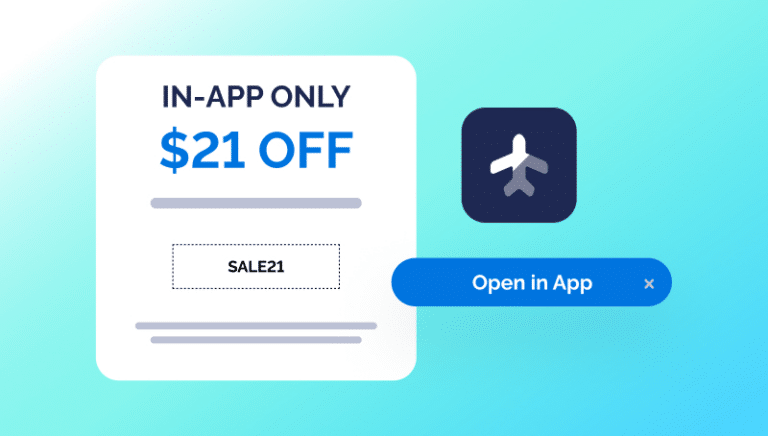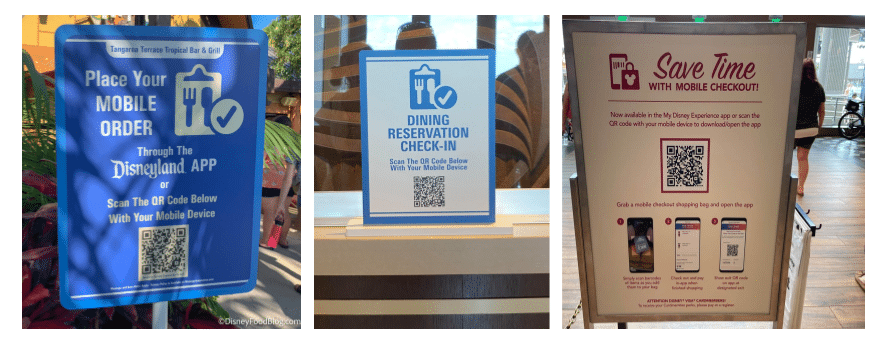Mobile apps have revolutionized customer experiences across most industries, perhaps none more than travel. With travelers constantly on the go — from airport to car rental stand to hotel — apps offer the easiest, fastest, and safest means for engagement.
Imagine the convenience of an app-first travel experience: you receive a personalized push notification reminding you to check in for your upcoming flight and in a couple of taps, you’ve booked an Lyft to the airport. Once you arrive, you bypass the line with your mobile boarding pass. While you’re in the airport, you receive real-time updates on flight statuses, gate changes, and delays. When you land at your destination, it only takes 10 minutes to pick up your rental car because you’ve digitally signed all the required paperwork in the app. As a member of the loyalty program, you even get a free upgrade to a nicer car. You get the idea.
There is also a massive upside for travel brands that embrace an app-first strategy. Take carriers, for example, who are perpetually trying to reduce their cost to serve and inbound call center traffic. By building robust app functionality and incentivizing customers to self-serve, travel brands can reduce the high costs associated staffing call centers and managing reservations. Apps are also major revenue drivers. A recent deep dive into four major hotel brands by Branch showed that conversions were 2.6x higher in app than on the mobile web.
But despite the revenue and loyalty potential, the majority of user traffic still remains on the mobile web. Recent data shows that just 20.2% of American Airlines’s mobile traffic flows through its app, and Delta Airlines trails even further at 14.6%.
Source: Apptopia, Similarweb
How can travel brands grow app adoption without skyrocketing their paid media budgets? The answer lies in owned channels. You can maximize app adoption by deploying calls-to-action that deep link users directly to the app and targeting customers at the right moment in their journey. Here are four ways to turn your owned channels into app marketing channels.
Web to app: Capitalize on mobile engagement
Transitioning users from mobile web to app is a goldmine for travel brands. Given that users are already engaged on their smartphones, the conversion potential is high. However, it requires thoughtful execution.
Brands traditionally used static web banners to encourage mobile web visitors to view and download their app in the app store, but they saw low conversion rates. Static banners give users a clunky web-to-app experience, disappear as soon as a user scrolls down the page, and lack targeting and personalization capabilities. Plus, they provide zero attribution beyond the initial click, so brands lacked visibility into down-stream user behavior and conversions.
Now, smart banners offer robust functionality, enabling travel brands to deliver highly targeted, personalized messages to web visitors. Instead of a one-size-fits-all banner, brands can use rules-based and content-related dynamic banners to serve users with the right message and the right intensity at the right time. To make the most of these capabilities and improve the likelihood of conversion, it’s critical to match your smart banner strategy to the intent of your users. Here’s how.
Top-of-funnel (low intent)
For users exploring your mobile website for the first time, deploy subtle, small banners at the top or bottom to let them know your app exists. The Choice Hotels app illustrates an unobtrusive way to get mobile web users’ attention without causing banner fatigue.h+
Mid-funnel (medium intent)
Engage users who have logged in or visited your mobile site multiple times with more substantial banners, like a quarter or half-page interstitial. The Dyrt app is a prime example of a half-page banner designed to persuade users to download the app for a better experience: “Browsing campaign maps is even easier in our app. Download now and see thousands of campgrounds near you.”
Bottom-of-funnel (high intent)
Users who have just completed a significant action on your mobile website (e.g., a purchase) have the highest likelihood of downloading an app, warranting a full-page banner with a compelling call to action. Expedia’s full-page interstitial incentives high-intent users to switch the app by offering 20% and loyalty rewards.
Desktop to app: Unlock desktop potential
Despite the dominance of mobile, desktop is still a major tool for travel-related research and transactions. Yet many brands overlook this traffic, dismissing it as a different platform that is “too far” from mobile.
The reality is that many of us sit at our laptops with our phones right beside us. All brands need to do to transition desktop users to mobile users is give a clear path and reason to do so. Here’s how.
Add passive QR codes to desktop landing pages
Proven catalysts for desktop-to-app transitions, QR codes enable immediate user action with a simple camera scan and provide brands with accurate attribution data. It’s crucial to implement mobile-optimized QR codes to avoid the common pitfall of directing users to the app store without proper tracking. QR codes also unlock deferred deep linking possibilities, facilitating personalized experiences like automatically activating promo codes or seamlessly guiding users back to specific pages or itineraries. CQ Hotels adopts this strategy to promote its mobile app with a QR code display on its desktop website, offering visitors a quick and easy “shortcut” to the app.
Promote app-only offers to accelerate installs
Fast-track the journey to your app by spotlighting exclusive features and deals available only for app users. Strategically placed banners, pop-ups, or QR codes that deliver incentivized discounts or offers not only accelerate adoption but also serve as a compelling reason for users to explore your app. Hotwire incorporates app CTAs across its desktop site, including app-exclusive sales and lower prices.
Offline QR codes: Reach beyond digital boundaries
Whether on billboards, menus, or within physical spaces, offline QR codes can transcend “digital boundaries” to reach almost any audience. Plus, on-site audiences typically have higher intent, making them ideal candidates to push to your mobile app via QR code scan. We see prime examples of this in the quick-service restaurant (QSR) world every day: industry giants like Starbucks and Wendy’s incorporate QR codes on their signage and packaging to ensure that every label becomes a gateway to app downloads. Travel brands can do the same by ensuring their physical interactions with customers provide a direct, convenient pathway to their mobile apps.
Disney Parks strategically deploys QR codes throughout its park that serve practical purposes, such as expediting mobile checkouts in the My Disney Experience app and streamlining food orders in the Disneyland app. For users that don’t have an app installed, a deferred deep link will kick in post-install to take users directly to the relevant in-app page. This creates a win-win scenario for everyone: visitors avoid waiting in lines and parks reduce their overhead labor costs.
Referrals: Leverage customer advocacy
When we think of referral programs, we typically think of brands like Airbnb and Robinhood, but referrals are also highly effective for travel brands. Mobile referral programs involve rewarding users for promoting your app through various channels like text, email, or social messaging. Given the high acquisition costs in the travel industry, travel brands have the luxury of offering generous financial rewards and incentives to their customers in exchange for referrals.
Here’s how to make your program successful.
Use deep links to ensure seamless transitions to the app
Ensure a smooth and personalized experience by incorporating deep links into your referral program. Deep links direct referred users straight to specific content or personalized onboarding flows in the app and can ensure any referral context (e.g., rewards points, discounts) is automatically applied upon app installation. By implementing deep links, you create a frictionless journey for both the referring and referred users.
Provide compelling referral incentivizes
Encourage users to share your app with enticing and easily-shareable referral content. Whether it’s exclusive deals, limited-time offers, or new app features, the referral process needs to be appealing to the referrers and those they refer.
Hotel Tonight uses referral links to foster viral growth through its referral program. In a two-screen process, users create a referral deep link, which also provides a deep view with a coupon code for added assurance. The deep link directs users to the sign-up page, confirming the upcoming reward. Once the referred user opens the app, they see a reward confirmation, “Welcome [User’s Name], your friend Amanda gave you $25.” In this scenario, deep linking is instrumental in building user trust and minimizing the steps required to activate the reward.
The road to 100% app adoption
Apps are the cornerstone of success for top travel brands, providing platforms for seamless experiences. But, reaping the rewards of a successful mobile app requires that brands embrace an app-first strategy. To delve deeper into strategies for driving 100% app adoption and learn from real brands’ successes and failures, tune into Branch’s on-demand webinar, “Why App-first Travel Brands Are Stealing Your Customers (and How To Win Them Back).” Discover how Branch can support your journey to app growth by requesting a demo with our team.































